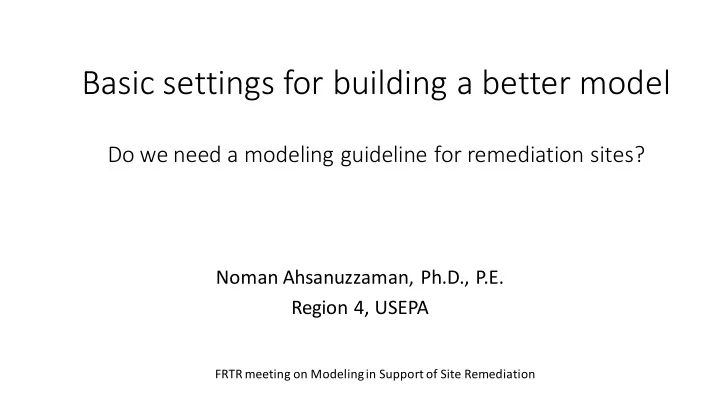

Basic settings for building a better model Do we need a modeling guideline for remediation sites? Noman Ahsanuzzaman, Ph.D., P.E. Region 4, USEPA FRTR meeting on Modeling in Support of Site Remediation
Outline • Few Important matters for setting up a groundwater model • Basic checks for a flow and transport model • Uncertainty analysis • Do we need a modeling guideline?
Before Modeling • CSM (conceptual site model) • X-section and Plan view of the model domain • Physical and Hydrogeologic conditions (e.g., porous system or fractured rock) • Modeling objectives • Data availability/Data gap? • Data review • Is modeling necessary to get an answer for decision making?
Initial Preparation for groundwater modeling • What datasets represent the best steady-state flow condition? • Separate datasets for calibration and validation • Are there any datasets for transient flow calibration? • Identify the Target wells • Is the source mass/concentration decaying? • What is a reasonable estimate for partitioning coefficient (i.e., retardation factor) • Is biodegradation happening? What rate? • Is the selected modeling package robust enough to handle the geochemical processes?
Model setup • Large enough model domain. • Lithology well represented in the model layers? • Boundary Conditions well understood; • Find a set of target wells near the boundaries to validate the boundary values • Do not set up ‘Head Boundary’ near an extraction well • Calibration Targets: Do not average the elevation data instead use a given sampling dataset (snapshot)
Calibration of the flow model • Most data is available for flow model calibration • Transport model depends on the flow model • Manual vs. Automated (PEST)? • PEST is popular among modelers/consultants • Pilot Points in PEST should be limited in numbers and have a tight range for each parameter • Initial values are sensitive in PEST calibration • Start with manual calibration and then improve with PEST – Rarely/Never done in practice !! • Calibration criteria in industry is NRMSE <= 10% • NRMSE (Normalized Root Mean Square of Error) • NRMSE = RMSE/(Range of Observed Head) ×100% • Goal should be NRMSE≈5% in the key areas
Calibration/Validation • Residual Distribution Map • Residual Error should be well distributed • Avoid bias to minimize error in hydraulic gradient • Validation should be done with a dataset not used in calibration • Calibration-Validation is an iterative process Calibration Validation • Validation is not popular among consultants
Sensitivity/Uncertainty Analysis • Parameter sensitivity is most commonly done in practice • Again, not so popular among consultants • Common practice is to compare the RMSE values between simulated and the calibrated models . • Doesn’t help in decision making, since it doesn’t address sensitivity to the model objectives. • It doesn’t show how the model output is sensitive to any model parameter change . For example , • Plume containment in a pump & treat system • Time to reach any cleanup goal • We expect to see model uncertainty as it relates to the modeling objectives and identify data gaps to address that uncertainty.
Solute Transport Model • Two common questionable practices • Retardation Factor (RF) is too high! • Source is instantaneous/initial • RF could be estimated in the following ways, 1. Find the partitioning coefficient (K d ) from batch or column test 2. Measure fraction of organic carbon (f OC ) from the site soil and use literature to get K OC for each COC. ( Most Common ) 3. Calibrate in the solute transport model ( very rarely done ) • Batch test will generate high values of K d (and thus RF), • f OC from the contaminated subsurface soil sample will be very high and thus result in high RF ( very common mistake ) • Initial estimation from column test of undisturbed soil sample followed by model calibration may be the best option. • Always do particle tracking modeling before transport model.
Solute Transport/ Instantaneous Source • Initial concentration of the plume is assigned, but no continuous source! • Plume in the source area will deplete quickly unless the K d is very high (Figure) • Historic matching of the source area concentration must be done. EW-1 EW-2 Average Minimum Maximum Average Minimum Maximum 10
The Solution? • Get involved early, not after the consultant has completed his calibration and used up all the funding. ( often the case ) • Do we need a guideline for modeling? • Modeling world is vast and it’s hard to cover every aspect through a guideline • Should we just highlight the common issues rather than trying to cover the broad spectrum in modeling world? • In my view, starting from small is always better!
Thank You
Recommend
More recommend